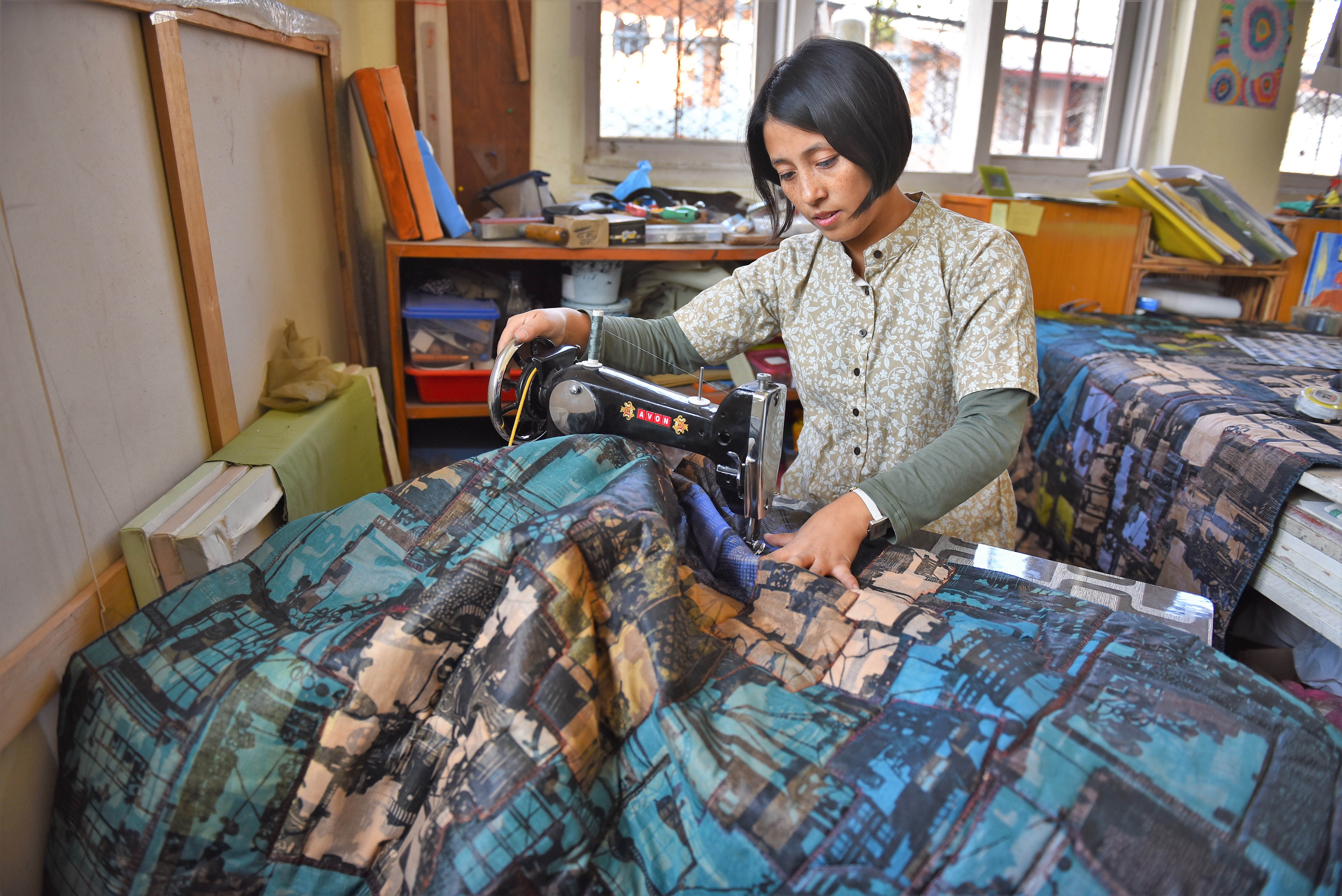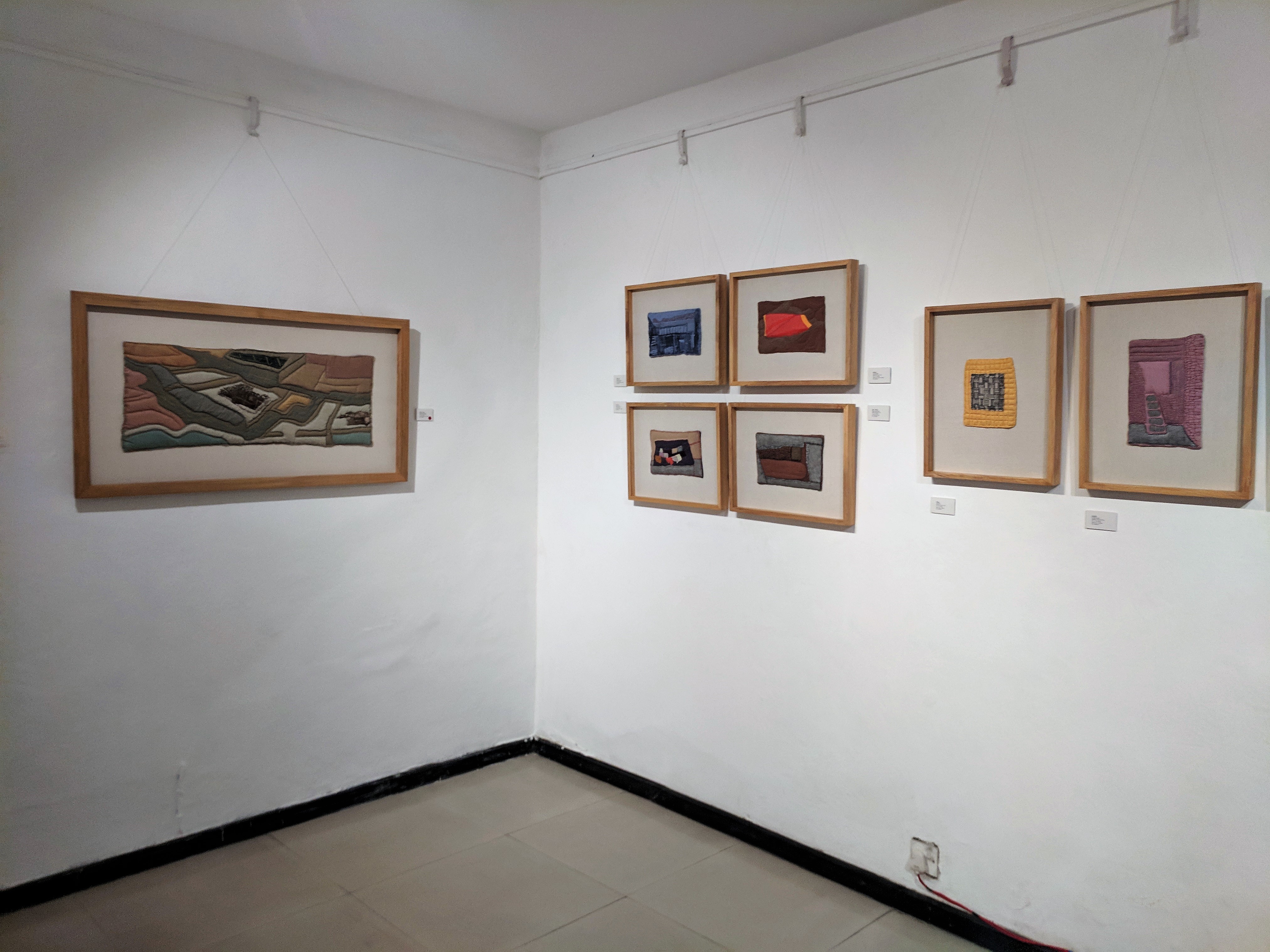
Features
8 MIN READ

With bold experimentations in mixed media and a continuing desire to learn and evolve, Sunita Maharjan is well on her way to becoming a pioneering Nepali artist.

I first came across Sunita Maharjan’s work at her 2018 exhibition Shared Skies. I was struck by Maharjan’s ability to switch among an array of mediums — ink on glass, photographs, stitchings. Besides, her distinctive representations of human dwellings and how people create personal boundaries stayed with me.
I even held on to a handful of postcards with pictures of her work for quite some time. I do not have them anymore, but that is only because I sent these artworks to a cherished few.
So when I came across Maharjan’s exhibits at this year’s Kathmandu Triennale, my past appreciation of her work came flooding back. I decided to take this opportunity to learn more about an artist I have grown to admire while also writing about her and her work.
So who is Sunita Maharjan?

Maharjan, 36, is a visual artist and art educator based in Kirtipur, Kathmandu. She is also one of the founding members of Srijanalaya as well as the co-founder of Drawing Room KTM. She has been working in and studying the arts for a little over two decades, first starting proper practice as a student in 2001. Since then, Maharjan has had two solo exhibitions, four series of artworks, and has worked and studied in Amsterdam, Kathmandu, Marpha, and Lahore.
But Maharjan is more than just numbers, places, and titles. Beneath all of it, there’s a Kirtipuri girl from an agrarian family.
“I’ve always loved to draw and paint. But I never really had the chance to explore materials and tools growing up. I went to a local government school, and art education was never a priority there,” she said.
For someone who has a knack for experimenting with different mediums, Maharjan says that she discovered her love for art with just a pencil.
“I’d simply just use a pencil and draw on whatever writable surface that I could find,” she said.
Discovering herself as an artist
The journey of an artist is one of self-discovery. For Maharjan, it seemed to be in relation to how she chose to create her art forms.

“Often, as art students and academics, you end up focused on honing your skills and craft. You end up striving for technical perfection,” she said. “While technical skill is crucial for any artist, the true goal is to be true to your identity and express your ideas in the best way possible.”
Maharjan’s childhood was filled with natural materials, which she found while playing in the fields, or in her mother’s sewing. The realization that art does not need a specific medium was a climactic moment for her. Maharjan admits that she is still most comfortable with a pen and paper but is also looking for a medium that will best allow her to showcase her ideas, rather than the medium determining what she is able to create.
Take, for instance, her Marpha series, a collection of artwork produced entirely with cloth and knitwork. She started work on this series during her stint as an artist in residency at the Marpha Art Foundation in Mustang. She says that she chose this particular medium because it was something that the people of the region already employed.

“When I went to Marpha, my goal was not to produce a lot of pieces, but rather to assimilate with the people and the culture,” she said. “I did not want me or my work to be too distinct. I realized that if I relied on standard paint and canvas, it was likely that the people would treat me differently and I would have become the center of their focus. Instead, if I picked a medium that was already mundane to them — like sewing and knitwork — I could be a quiet observer.”
Translating inspiration across mediums
“A lot of people have inspired me throughout my career. Nabendra Limbu and Ashmina Ranjit were two who really inspired me early on,” said Maharjan. “I admired the way Nabendra Limbu used form, patterns, and muted colors while I found Ashmina Ranjit’s work to be very bold. It also showed me how different art can be.”
Other notable inspirations for Maharjan include Paul Klee, Andy Goldsworthy, and South Korean sculptor Do Ho Suh. It was Suh’s work that led to Maharjan’s own gripping study of how one can define intangible spaces, most notably through her Terraces series. Suh’s work helped cement her love for architectural structures and her fascination with straight lines.
Maharjan also takes inspiration from places and events, especially those encountered while traveling.
“I got a chance to travel to Gatlang after the earthquake. The unvarying architecture of the village was really intriguing. But the earthquake had moved the people out of their households and into temporary settlements in fields,” she said. This allowed her to see people busy in their own individual activities in open spaces, outside of the hidden confines of their walls. She noted how, while the houses and neighborhoods of Gatlang all shared a similar facade, each of those houses enclosed unique individual spaces within the confines of their walls.

“Any space that exists is made through activity. Not by the physical structures itself, but rather the formation of those structures through time and activity,” said Maharjan.
This is a significant theme in Maharjan’s work, one that she returns to again and again. During her 2018 solo exhibition, Shared Skies, she had written, “I want to depict human activity without the presence of human figures.”
Her two most recent pieces — ‘Act of Finding Line’ and ‘Above the Earth, Beneath the Sky’, both of which had been commissioned for the Kathmandu Triennale — work in tandem with her previous work, while also highlighting her growth as an artist.
With these two installations, in signature fashion, Maharjan has continued her experimentation with mediums, working with organic elements like seeds. Writing for The Kathmandu Post, Ankit Khadgi, in his recent review of the Kathmandu Triennale, said that Maharjan’s installations were “creative and pushing the boundaries of art.”

More than just an artist
Maharjan does not just transcend mediums. She also works for impact, beyond what can be achieved through art alone. Srijanalaya and the Draw Room KTM were both born out of a desire to improve the Nepali art space and emphasize art education. But Maharjan clarified that the two have very different goals. For Srijanalaya, the primary objective is to bring communities and people of different ages closer to art, whether through exhibitions such as the Triennale, Nepali children's books, or other ways of developing an appreciation for the arts. Drawing Room KTM shares the same sentiment, but here, the goal is to bring people closer to art by helping improve their technical capacities and providing them with a space to develop and incubate their art.
“I think art is not just a subject of its own. Rather it is an integrative study that should be a part of other areas of study,” said Maharjan.
Growing and pioneering
Maharjan is well on her way to becoming a pioneering artist in the Nepali art scene. Her experimentation with art forms and different media show that she is continually growing as an artist.
For the time being, Maharjan does not have any concrete plans but she does plan to get back to the proposals she had made as a graduate student at the Beaconhouse National University in Lahore, Pakistan.
“I wasn’t able to complete a lot of my proposals because of restrictions put in place by the pandemic. A lot of my ideas sought to be physically imposing and required more time, budget, and space. I got to turn one of them into reality during the Triennale, and I hope that I can do the same for more of them,” said Maharjan.

Sangeeta Thapa, art curator and director of the Siddhartha Art Gallery, too shares my fascination with Maharjan’s work. Thapa said that she has been following Maharjan all the way back when she was still a fine arts undergraduate at Kathmandu University.
“I think of her as one of the pioneer artists of Nepal. She’s one of the people we have to watch out for,” said Thapa. “When you look at Sunita, physically she’s a very small person. But look at the diversity and the scale of the work she makes. She can draw, she can sew, she can sow, she can create structures; she is very dextrous and unafraid of experimenting. I don’t know what she’ll take on next or where her inspiration will come from, but I can only see her growing in the days to come. She’s most certainly a name to remember in the Nepali art scene.

Sajeet M. Rajbhandari Sajeet is a Media Studies undergraduate and is currently reporting for The Record.


Features
5 min read
A look into the psychedelic culture's white-man problem.
Books
4 min read
Former finance minister Madhukar SJB Rana’s posthumously published book provides lessons in development and the economy for policymakers.
Perspectives
7 min read
Tim Gurung reflects on his time as a businessman in Hong Kong and China and how the world of business taught him lessons about how the world works.
Photo Essays
7 min read
How the Rais of Bhojpur use alcohol to soften life’s blows
Writing journeys
9 min read
Writer and educator Niranjan Kunwar reflects on his writing process and provides advice on how to make your words fly.
Features
8 min read
The rise of food delivery companies in Kathmandu reflects the expansion of the city’s middle-class and their changing appetites.
COVID19
Features
10 min read
Several inmates have died by suicide while many others have been hobbled by the depression and anxiety resulting from conditions inside Nepal’s ill-managed quarantine facilities
Features
6 min read
The Record introduces a new mini-series where we speak to artists from various fields and ask them about the projects they worked on during the lockdown and the pandemic.